Report on Branding and Marketing: Importance, Building Brands and IMC
VerifiedAdded on 2022/11/28
|11
|2116
|191
Report
AI Summary
This report provides a comprehensive overview of branding and marketing, emphasizing their significance in business success. It explores the meaning and importance of marketing and branding, highlighting how companies build brand image and reputation. The report delves into the development of conceptual models, brand building processes, and the role of integrated marketing communication (IMC). It discusses measuring the effectiveness of branding and marketing efforts, including benchmarking and stakeholder involvement. The report also examines the steps involved in brand building, such as brand differentiation, promotion, and evaluation. Furthermore, it analyzes the value of IMC capabilities in enhancing brand performance and fostering customer engagement. In conclusion, the report underscores the crucial role of branding and marketing in achieving business goals and establishing a strong market presence. It also includes references to key academic sources on the topic.
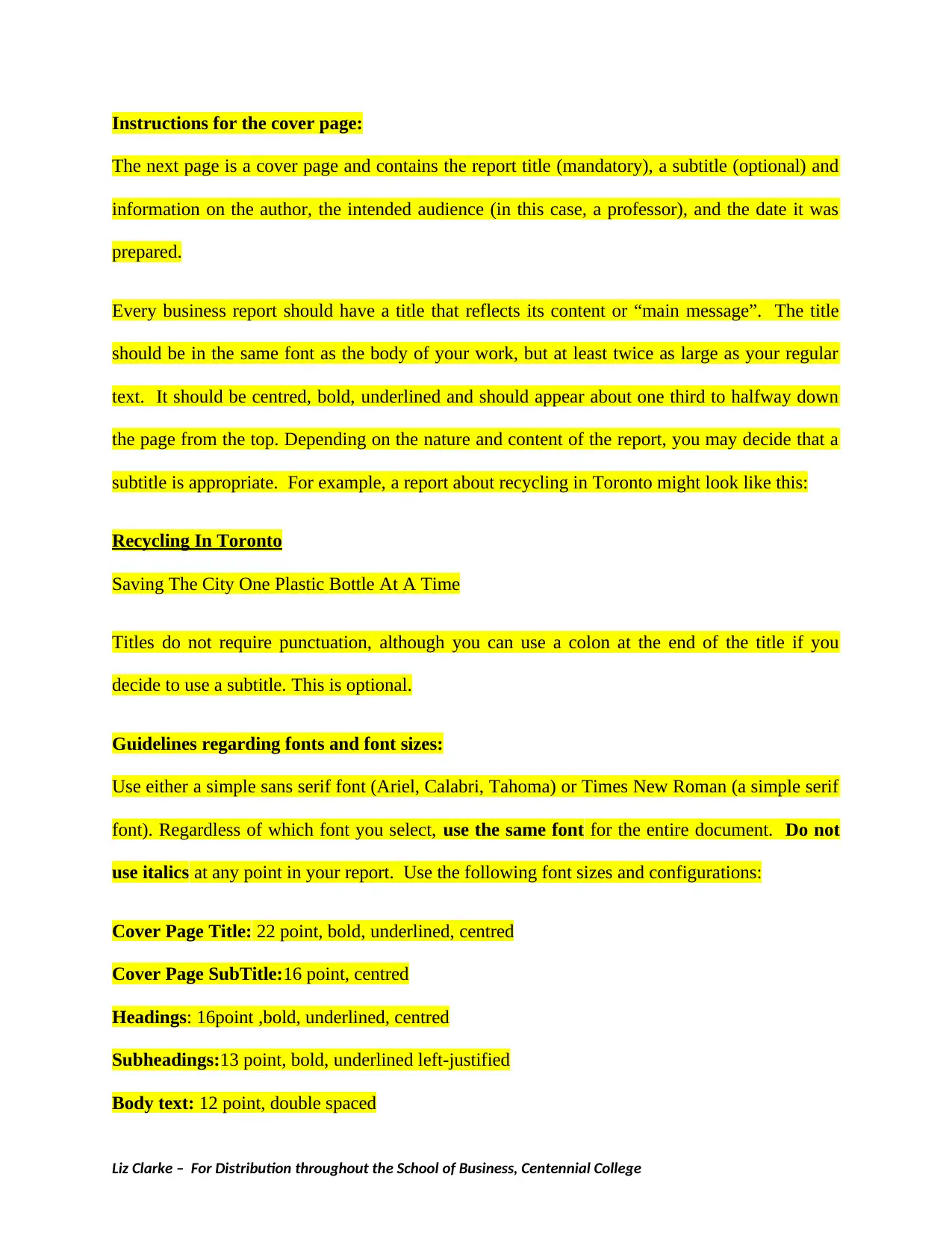
Instructions for the cover page:
The next page is a cover page and contains the report title (mandatory), a subtitle (optional) and
information on the author, the intended audience (in this case, a professor), and the date it was
prepared.
Every business report should have a title that reflects its content or “main message”. The title
should be in the same font as the body of your work, but at least twice as large as your regular
text. It should be centred, bold, underlined and should appear about one third to halfway down
the page from the top. Depending on the nature and content of the report, you may decide that a
subtitle is appropriate. For example, a report about recycling in Toronto might look like this:
Recycling In Toronto
Saving The City One Plastic Bottle At A Time
Titles do not require punctuation, although you can use a colon at the end of the title if you
decide to use a subtitle. This is optional.
Guidelines regarding fonts and font sizes:
Use either a simple sans serif font (Ariel, Calabri, Tahoma) or Times New Roman (a simple serif
font). Regardless of which font you select, use the same font for the entire document. Do not
use italics at any point in your report. Use the following font sizes and configurations:
Cover Page Title: 22 point, bold, underlined, centred
Cover Page SubTitle:16 point, centred
Headings: 16point ,bold, underlined, centred
Subheadings:13 point, bold, underlined left-justified
Body text: 12 point, double spaced
Liz Clarke – For Distribution throughout the School of Business, Centennial College
The next page is a cover page and contains the report title (mandatory), a subtitle (optional) and
information on the author, the intended audience (in this case, a professor), and the date it was
prepared.
Every business report should have a title that reflects its content or “main message”. The title
should be in the same font as the body of your work, but at least twice as large as your regular
text. It should be centred, bold, underlined and should appear about one third to halfway down
the page from the top. Depending on the nature and content of the report, you may decide that a
subtitle is appropriate. For example, a report about recycling in Toronto might look like this:
Recycling In Toronto
Saving The City One Plastic Bottle At A Time
Titles do not require punctuation, although you can use a colon at the end of the title if you
decide to use a subtitle. This is optional.
Guidelines regarding fonts and font sizes:
Use either a simple sans serif font (Ariel, Calabri, Tahoma) or Times New Roman (a simple serif
font). Regardless of which font you select, use the same font for the entire document. Do not
use italics at any point in your report. Use the following font sizes and configurations:
Cover Page Title: 22 point, bold, underlined, centred
Cover Page SubTitle:16 point, centred
Headings: 16point ,bold, underlined, centred
Subheadings:13 point, bold, underlined left-justified
Body text: 12 point, double spaced
Liz Clarke – For Distribution throughout the School of Business, Centennial College
Paraphrase This Document
Need a fresh take? Get an instant paraphrase of this document with our AI Paraphraser

DELETE THIS PAGE BEFORE YOU HAND IN YOUR WORK!
Liz Clarke – For Distribution throughout the School of Business, Centennial College
Liz Clarke – For Distribution throughout the School of Business, Centennial College

The Title Of Your Report
The Subtitle of Your Report
Your Name
Your Student Number
Professor’s Name
The Subtitle of Your Report
Your Name
Your Student Number
Professor’s Name
⊘ This is a preview!⊘
Do you want full access?
Subscribe today to unlock all pages.

Trusted by 1+ million students worldwide

Course Name
Course Code
Date Submitted
Course Code
Date Submitted
Paraphrase This Document
Need a fresh take? Get an instant paraphrase of this document with our AI Paraphraser
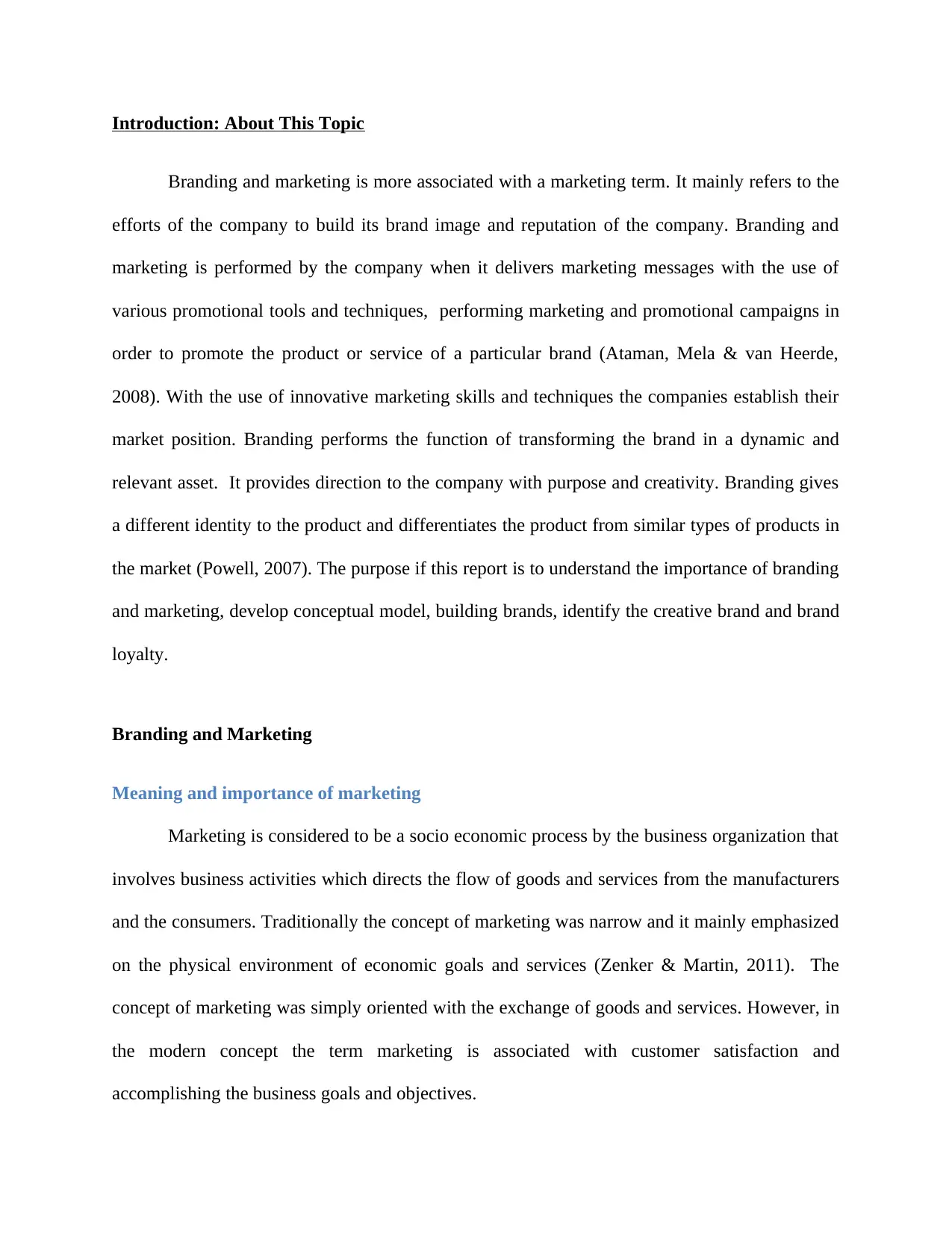
Introduction: About This Topic
Branding and marketing is more associated with a marketing term. It mainly refers to the
efforts of the company to build its brand image and reputation of the company. Branding and
marketing is performed by the company when it delivers marketing messages with the use of
various promotional tools and techniques, performing marketing and promotional campaigns in
order to promote the product or service of a particular brand (Ataman, Mela & van Heerde,
2008). With the use of innovative marketing skills and techniques the companies establish their
market position. Branding performs the function of transforming the brand in a dynamic and
relevant asset. It provides direction to the company with purpose and creativity. Branding gives
a different identity to the product and differentiates the product from similar types of products in
the market (Powell, 2007). The purpose if this report is to understand the importance of branding
and marketing, develop conceptual model, building brands, identify the creative brand and brand
loyalty.
Branding and Marketing
Meaning and importance of marketing
Marketing is considered to be a socio economic process by the business organization that
involves business activities which directs the flow of goods and services from the manufacturers
and the consumers. Traditionally the concept of marketing was narrow and it mainly emphasized
on the physical environment of economic goals and services (Zenker & Martin, 2011). The
concept of marketing was simply oriented with the exchange of goods and services. However, in
the modern concept the term marketing is associated with customer satisfaction and
accomplishing the business goals and objectives.
Branding and marketing is more associated with a marketing term. It mainly refers to the
efforts of the company to build its brand image and reputation of the company. Branding and
marketing is performed by the company when it delivers marketing messages with the use of
various promotional tools and techniques, performing marketing and promotional campaigns in
order to promote the product or service of a particular brand (Ataman, Mela & van Heerde,
2008). With the use of innovative marketing skills and techniques the companies establish their
market position. Branding performs the function of transforming the brand in a dynamic and
relevant asset. It provides direction to the company with purpose and creativity. Branding gives
a different identity to the product and differentiates the product from similar types of products in
the market (Powell, 2007). The purpose if this report is to understand the importance of branding
and marketing, develop conceptual model, building brands, identify the creative brand and brand
loyalty.
Branding and Marketing
Meaning and importance of marketing
Marketing is considered to be a socio economic process by the business organization that
involves business activities which directs the flow of goods and services from the manufacturers
and the consumers. Traditionally the concept of marketing was narrow and it mainly emphasized
on the physical environment of economic goals and services (Zenker & Martin, 2011). The
concept of marketing was simply oriented with the exchange of goods and services. However, in
the modern concept the term marketing is associated with customer satisfaction and
accomplishing the business goals and objectives.
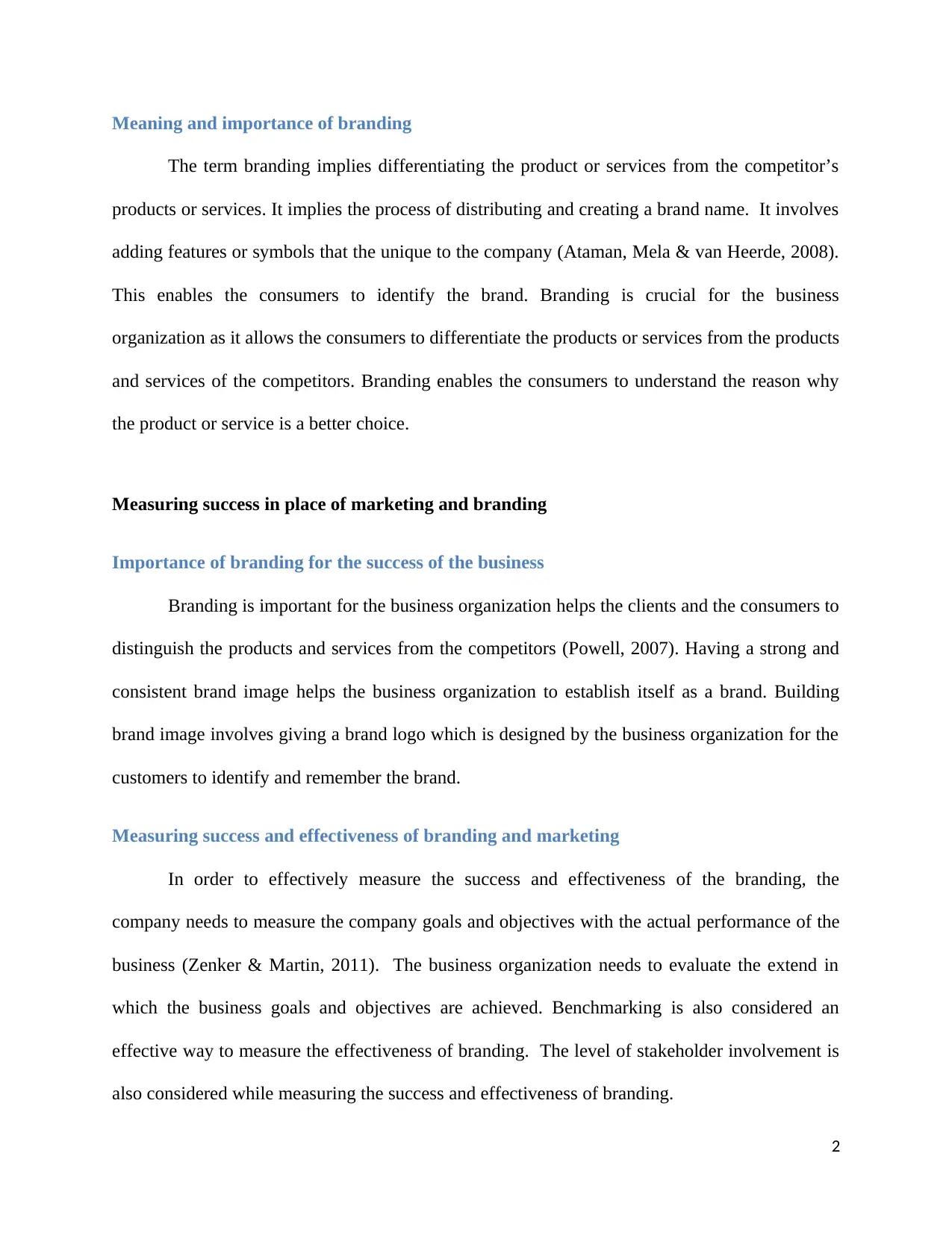
Meaning and importance of branding
The term branding implies differentiating the product or services from the competitor’s
products or services. It implies the process of distributing and creating a brand name. It involves
adding features or symbols that the unique to the company (Ataman, Mela & van Heerde, 2008).
This enables the consumers to identify the brand. Branding is crucial for the business
organization as it allows the consumers to differentiate the products or services from the products
and services of the competitors. Branding enables the consumers to understand the reason why
the product or service is a better choice.
Measuring success in place of marketing and branding
Importance of branding for the success of the business
Branding is important for the business organization helps the clients and the consumers to
distinguish the products and services from the competitors (Powell, 2007). Having a strong and
consistent brand image helps the business organization to establish itself as a brand. Building
brand image involves giving a brand logo which is designed by the business organization for the
customers to identify and remember the brand.
Measuring success and effectiveness of branding and marketing
In order to effectively measure the success and effectiveness of the branding, the
company needs to measure the company goals and objectives with the actual performance of the
business (Zenker & Martin, 2011). The business organization needs to evaluate the extend in
which the business goals and objectives are achieved. Benchmarking is also considered an
effective way to measure the effectiveness of branding. The level of stakeholder involvement is
also considered while measuring the success and effectiveness of branding.
2
The term branding implies differentiating the product or services from the competitor’s
products or services. It implies the process of distributing and creating a brand name. It involves
adding features or symbols that the unique to the company (Ataman, Mela & van Heerde, 2008).
This enables the consumers to identify the brand. Branding is crucial for the business
organization as it allows the consumers to differentiate the products or services from the products
and services of the competitors. Branding enables the consumers to understand the reason why
the product or service is a better choice.
Measuring success in place of marketing and branding
Importance of branding for the success of the business
Branding is important for the business organization helps the clients and the consumers to
distinguish the products and services from the competitors (Powell, 2007). Having a strong and
consistent brand image helps the business organization to establish itself as a brand. Building
brand image involves giving a brand logo which is designed by the business organization for the
customers to identify and remember the brand.
Measuring success and effectiveness of branding and marketing
In order to effectively measure the success and effectiveness of the branding, the
company needs to measure the company goals and objectives with the actual performance of the
business (Zenker & Martin, 2011). The business organization needs to evaluate the extend in
which the business goals and objectives are achieved. Benchmarking is also considered an
effective way to measure the effectiveness of branding. The level of stakeholder involvement is
also considered while measuring the success and effectiveness of branding.
2
⊘ This is a preview!⊘
Do you want full access?
Subscribe today to unlock all pages.

Trusted by 1+ million students worldwide
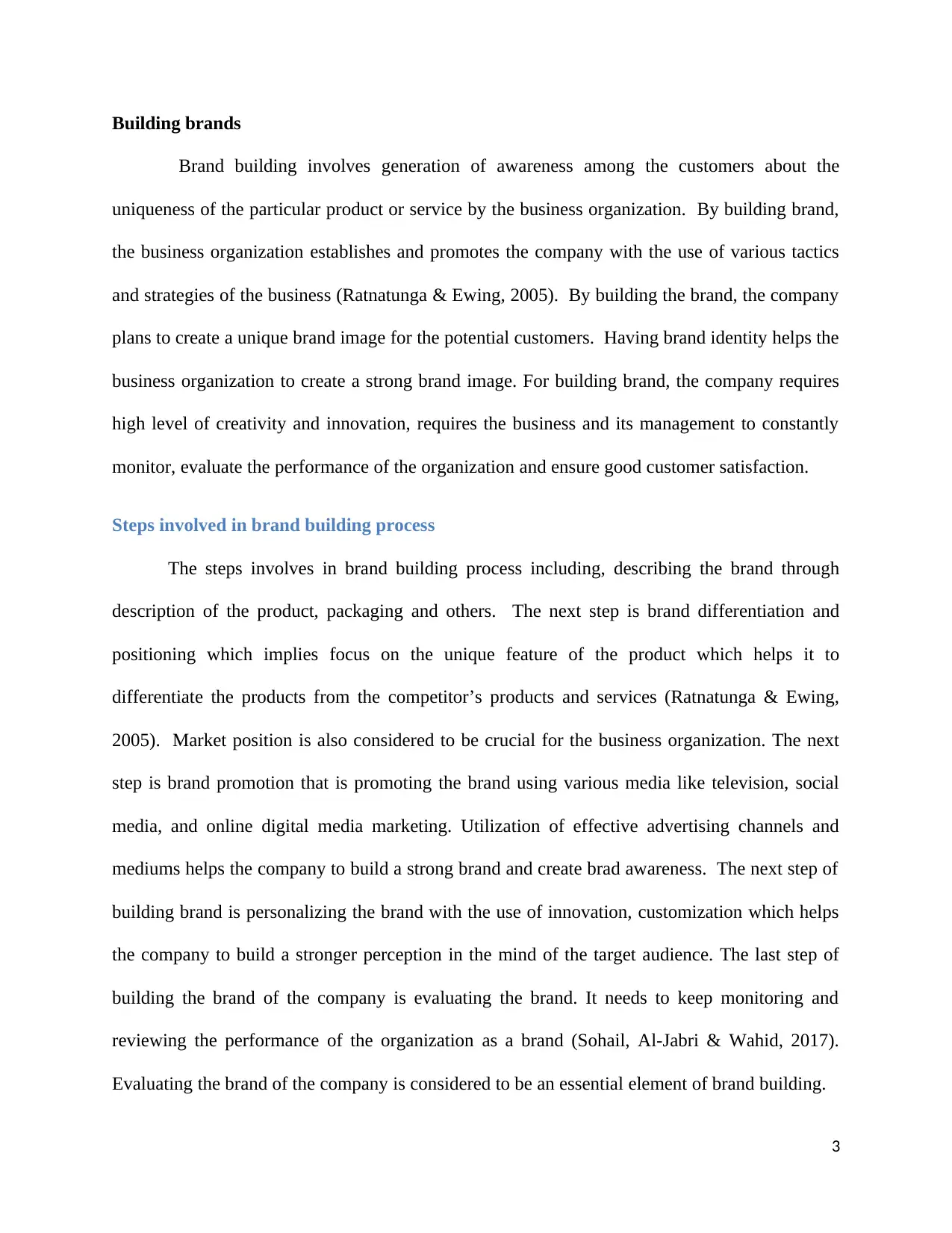
Building brands
Brand building involves generation of awareness among the customers about the
uniqueness of the particular product or service by the business organization. By building brand,
the business organization establishes and promotes the company with the use of various tactics
and strategies of the business (Ratnatunga & Ewing, 2005). By building the brand, the company
plans to create a unique brand image for the potential customers. Having brand identity helps the
business organization to create a strong brand image. For building brand, the company requires
high level of creativity and innovation, requires the business and its management to constantly
monitor, evaluate the performance of the organization and ensure good customer satisfaction.
Steps involved in brand building process
The steps involves in brand building process including, describing the brand through
description of the product, packaging and others. The next step is brand differentiation and
positioning which implies focus on the unique feature of the product which helps it to
differentiate the products from the competitor’s products and services (Ratnatunga & Ewing,
2005). Market position is also considered to be crucial for the business organization. The next
step is brand promotion that is promoting the brand using various media like television, social
media, and online digital media marketing. Utilization of effective advertising channels and
mediums helps the company to build a strong brand and create brad awareness. The next step of
building brand is personalizing the brand with the use of innovation, customization which helps
the company to build a stronger perception in the mind of the target audience. The last step of
building the brand of the company is evaluating the brand. It needs to keep monitoring and
reviewing the performance of the organization as a brand (Sohail, Al-Jabri & Wahid, 2017).
Evaluating the brand of the company is considered to be an essential element of brand building.
3
Brand building involves generation of awareness among the customers about the
uniqueness of the particular product or service by the business organization. By building brand,
the business organization establishes and promotes the company with the use of various tactics
and strategies of the business (Ratnatunga & Ewing, 2005). By building the brand, the company
plans to create a unique brand image for the potential customers. Having brand identity helps the
business organization to create a strong brand image. For building brand, the company requires
high level of creativity and innovation, requires the business and its management to constantly
monitor, evaluate the performance of the organization and ensure good customer satisfaction.
Steps involved in brand building process
The steps involves in brand building process including, describing the brand through
description of the product, packaging and others. The next step is brand differentiation and
positioning which implies focus on the unique feature of the product which helps it to
differentiate the products from the competitor’s products and services (Ratnatunga & Ewing,
2005). Market position is also considered to be crucial for the business organization. The next
step is brand promotion that is promoting the brand using various media like television, social
media, and online digital media marketing. Utilization of effective advertising channels and
mediums helps the company to build a strong brand and create brad awareness. The next step of
building brand is personalizing the brand with the use of innovation, customization which helps
the company to build a stronger perception in the mind of the target audience. The last step of
building the brand of the company is evaluating the brand. It needs to keep monitoring and
reviewing the performance of the organization as a brand (Sohail, Al-Jabri & Wahid, 2017).
Evaluating the brand of the company is considered to be an essential element of brand building.
3
Paraphrase This Document
Need a fresh take? Get an instant paraphrase of this document with our AI Paraphraser
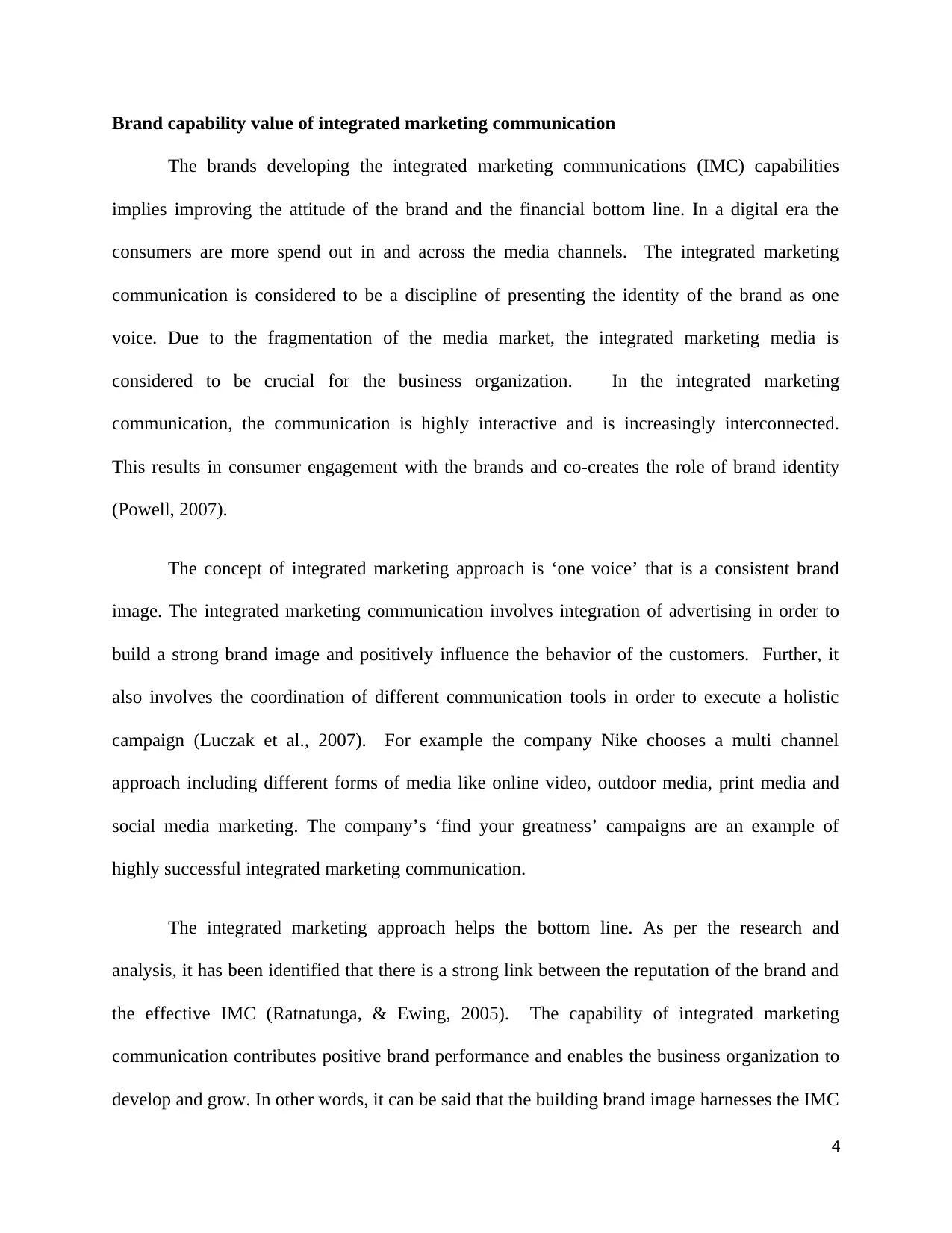
Brand capability value of integrated marketing communication
The brands developing the integrated marketing communications (IMC) capabilities
implies improving the attitude of the brand and the financial bottom line. In a digital era the
consumers are more spend out in and across the media channels. The integrated marketing
communication is considered to be a discipline of presenting the identity of the brand as one
voice. Due to the fragmentation of the media market, the integrated marketing media is
considered to be crucial for the business organization. In the integrated marketing
communication, the communication is highly interactive and is increasingly interconnected.
This results in consumer engagement with the brands and co-creates the role of brand identity
(Powell, 2007).
The concept of integrated marketing approach is ‘one voice’ that is a consistent brand
image. The integrated marketing communication involves integration of advertising in order to
build a strong brand image and positively influence the behavior of the customers. Further, it
also involves the coordination of different communication tools in order to execute a holistic
campaign (Luczak et al., 2007). For example the company Nike chooses a multi channel
approach including different forms of media like online video, outdoor media, print media and
social media marketing. The company’s ‘find your greatness’ campaigns are an example of
highly successful integrated marketing communication.
The integrated marketing approach helps the bottom line. As per the research and
analysis, it has been identified that there is a strong link between the reputation of the brand and
the effective IMC (Ratnatunga, & Ewing, 2005). The capability of integrated marketing
communication contributes positive brand performance and enables the business organization to
develop and grow. In other words, it can be said that the building brand image harnesses the IMC
4
The brands developing the integrated marketing communications (IMC) capabilities
implies improving the attitude of the brand and the financial bottom line. In a digital era the
consumers are more spend out in and across the media channels. The integrated marketing
communication is considered to be a discipline of presenting the identity of the brand as one
voice. Due to the fragmentation of the media market, the integrated marketing media is
considered to be crucial for the business organization. In the integrated marketing
communication, the communication is highly interactive and is increasingly interconnected.
This results in consumer engagement with the brands and co-creates the role of brand identity
(Powell, 2007).
The concept of integrated marketing approach is ‘one voice’ that is a consistent brand
image. The integrated marketing communication involves integration of advertising in order to
build a strong brand image and positively influence the behavior of the customers. Further, it
also involves the coordination of different communication tools in order to execute a holistic
campaign (Luczak et al., 2007). For example the company Nike chooses a multi channel
approach including different forms of media like online video, outdoor media, print media and
social media marketing. The company’s ‘find your greatness’ campaigns are an example of
highly successful integrated marketing communication.
The integrated marketing approach helps the bottom line. As per the research and
analysis, it has been identified that there is a strong link between the reputation of the brand and
the effective IMC (Ratnatunga, & Ewing, 2005). The capability of integrated marketing
communication contributes positive brand performance and enables the business organization to
develop and grow. In other words, it can be said that the building brand image harnesses the IMC
4
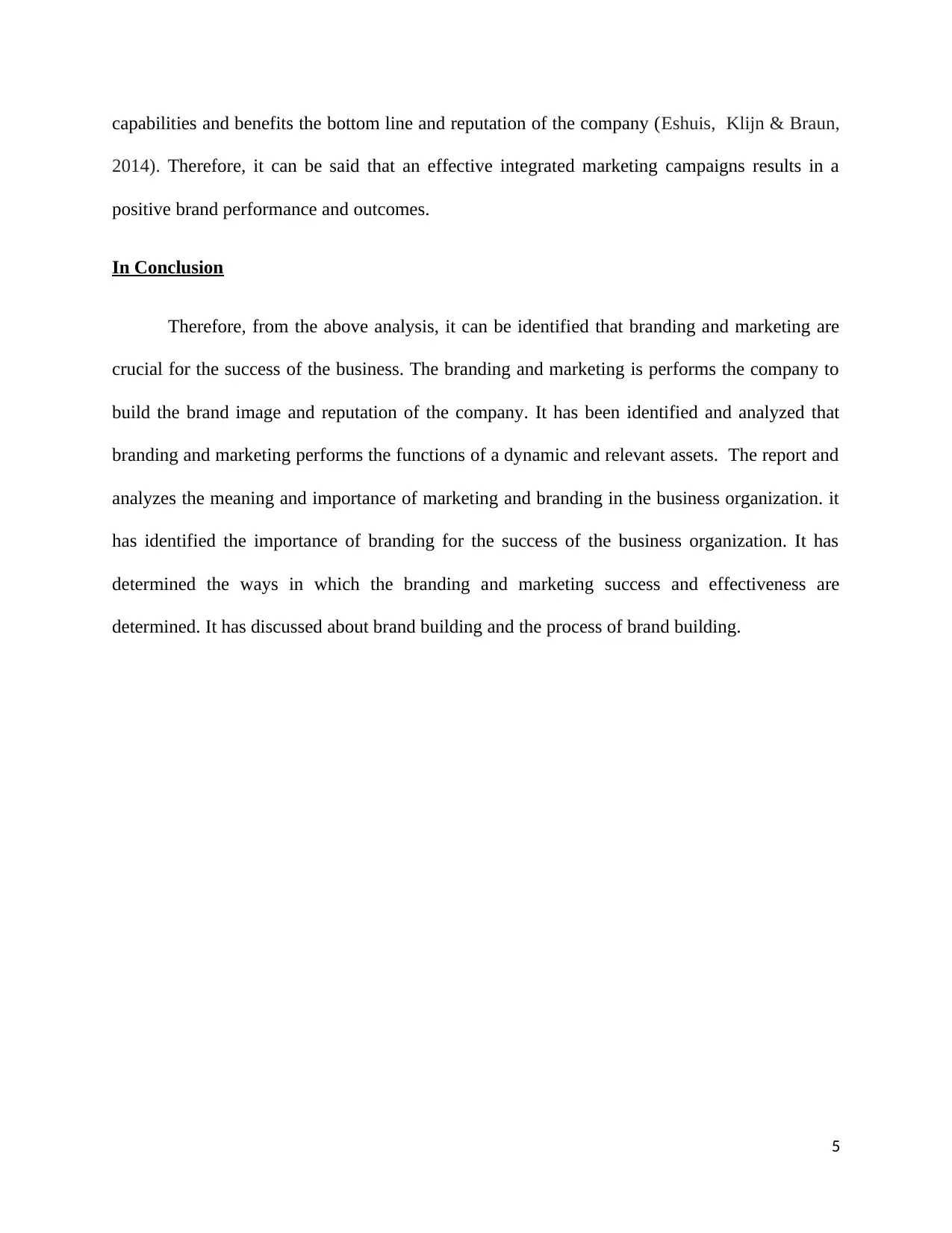
capabilities and benefits the bottom line and reputation of the company (Eshuis, Klijn & Braun,
2014). Therefore, it can be said that an effective integrated marketing campaigns results in a
positive brand performance and outcomes.
In Conclusion
Therefore, from the above analysis, it can be identified that branding and marketing are
crucial for the success of the business. The branding and marketing is performs the company to
build the brand image and reputation of the company. It has been identified and analyzed that
branding and marketing performs the functions of a dynamic and relevant assets. The report and
analyzes the meaning and importance of marketing and branding in the business organization. it
has identified the importance of branding for the success of the business organization. It has
determined the ways in which the branding and marketing success and effectiveness are
determined. It has discussed about brand building and the process of brand building.
5
2014). Therefore, it can be said that an effective integrated marketing campaigns results in a
positive brand performance and outcomes.
In Conclusion
Therefore, from the above analysis, it can be identified that branding and marketing are
crucial for the success of the business. The branding and marketing is performs the company to
build the brand image and reputation of the company. It has been identified and analyzed that
branding and marketing performs the functions of a dynamic and relevant assets. The report and
analyzes the meaning and importance of marketing and branding in the business organization. it
has identified the importance of branding for the success of the business organization. It has
determined the ways in which the branding and marketing success and effectiveness are
determined. It has discussed about brand building and the process of brand building.
5
⊘ This is a preview!⊘
Do you want full access?
Subscribe today to unlock all pages.

Trusted by 1+ million students worldwide
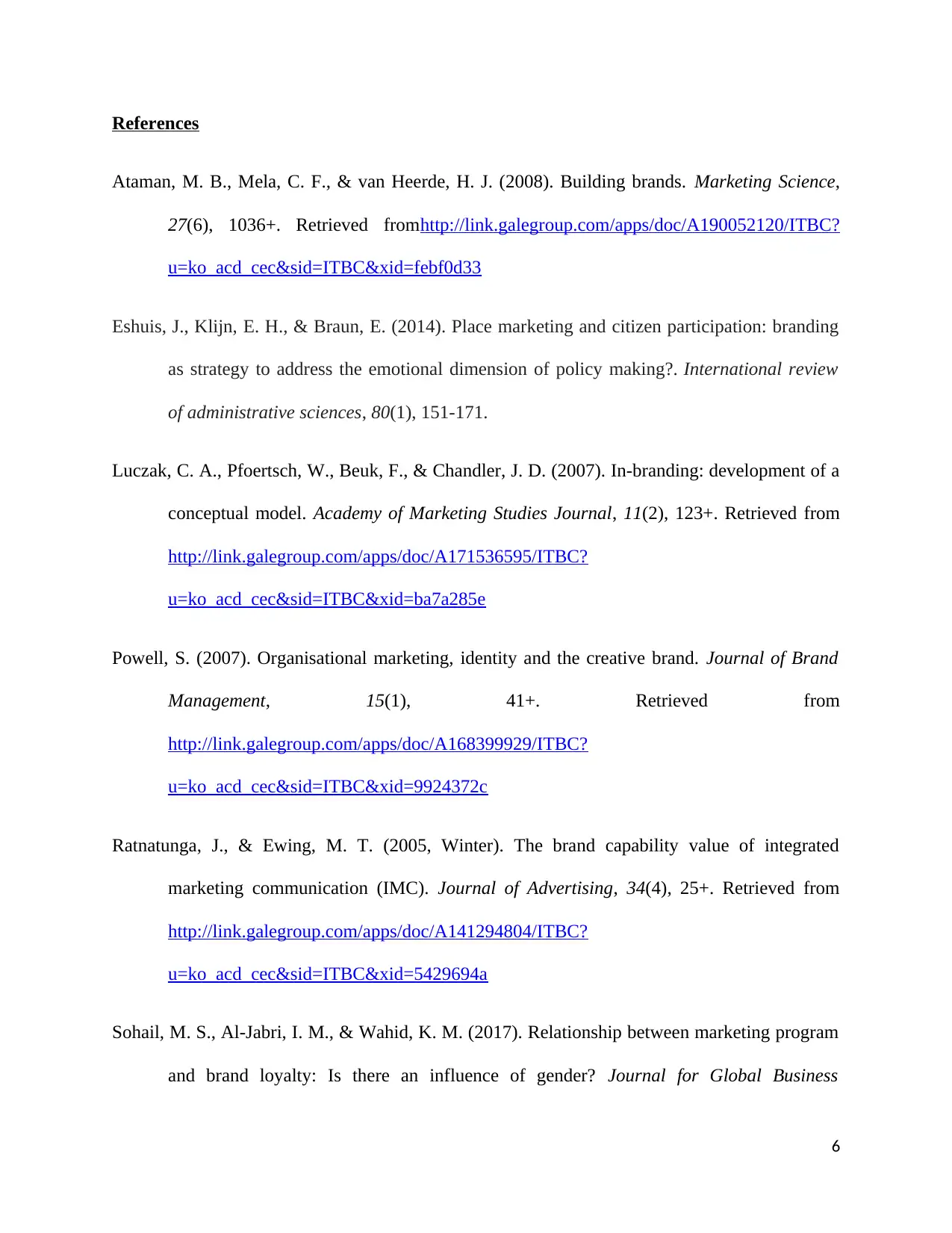
References
Ataman, M. B., Mela, C. F., & van Heerde, H. J. (2008). Building brands. Marketing Science,
27(6), 1036+. Retrieved fromhttp://link.galegroup.com/apps/doc/A190052120/ITBC?
u=ko_acd_cec&sid=ITBC&xid=febf0d33
Eshuis, J., Klijn, E. H., & Braun, E. (2014). Place marketing and citizen participation: branding
as strategy to address the emotional dimension of policy making?. International review
of administrative sciences, 80(1), 151-171.
Luczak, C. A., Pfoertsch, W., Beuk, F., & Chandler, J. D. (2007). In-branding: development of a
conceptual model. Academy of Marketing Studies Journal, 11(2), 123+. Retrieved from
http://link.galegroup.com/apps/doc/A171536595/ITBC?
u=ko_acd_cec&sid=ITBC&xid=ba7a285e
Powell, S. (2007). Organisational marketing, identity and the creative brand. Journal of Brand
Management, 15(1), 41+. Retrieved from
http://link.galegroup.com/apps/doc/A168399929/ITBC?
u=ko_acd_cec&sid=ITBC&xid=9924372c
Ratnatunga, J., & Ewing, M. T. (2005, Winter). The brand capability value of integrated
marketing communication (IMC). Journal of Advertising, 34(4), 25+. Retrieved from
http://link.galegroup.com/apps/doc/A141294804/ITBC?
u=ko_acd_cec&sid=ITBC&xid=5429694a
Sohail, M. S., Al-Jabri, I. M., & Wahid, K. M. (2017). Relationship between marketing program
and brand loyalty: Is there an influence of gender? Journal for Global Business
6
Ataman, M. B., Mela, C. F., & van Heerde, H. J. (2008). Building brands. Marketing Science,
27(6), 1036+. Retrieved fromhttp://link.galegroup.com/apps/doc/A190052120/ITBC?
u=ko_acd_cec&sid=ITBC&xid=febf0d33
Eshuis, J., Klijn, E. H., & Braun, E. (2014). Place marketing and citizen participation: branding
as strategy to address the emotional dimension of policy making?. International review
of administrative sciences, 80(1), 151-171.
Luczak, C. A., Pfoertsch, W., Beuk, F., & Chandler, J. D. (2007). In-branding: development of a
conceptual model. Academy of Marketing Studies Journal, 11(2), 123+. Retrieved from
http://link.galegroup.com/apps/doc/A171536595/ITBC?
u=ko_acd_cec&sid=ITBC&xid=ba7a285e
Powell, S. (2007). Organisational marketing, identity and the creative brand. Journal of Brand
Management, 15(1), 41+. Retrieved from
http://link.galegroup.com/apps/doc/A168399929/ITBC?
u=ko_acd_cec&sid=ITBC&xid=9924372c
Ratnatunga, J., & Ewing, M. T. (2005, Winter). The brand capability value of integrated
marketing communication (IMC). Journal of Advertising, 34(4), 25+. Retrieved from
http://link.galegroup.com/apps/doc/A141294804/ITBC?
u=ko_acd_cec&sid=ITBC&xid=5429694a
Sohail, M. S., Al-Jabri, I. M., & Wahid, K. M. (2017). Relationship between marketing program
and brand loyalty: Is there an influence of gender? Journal for Global Business
6
Paraphrase This Document
Need a fresh take? Get an instant paraphrase of this document with our AI Paraphraser
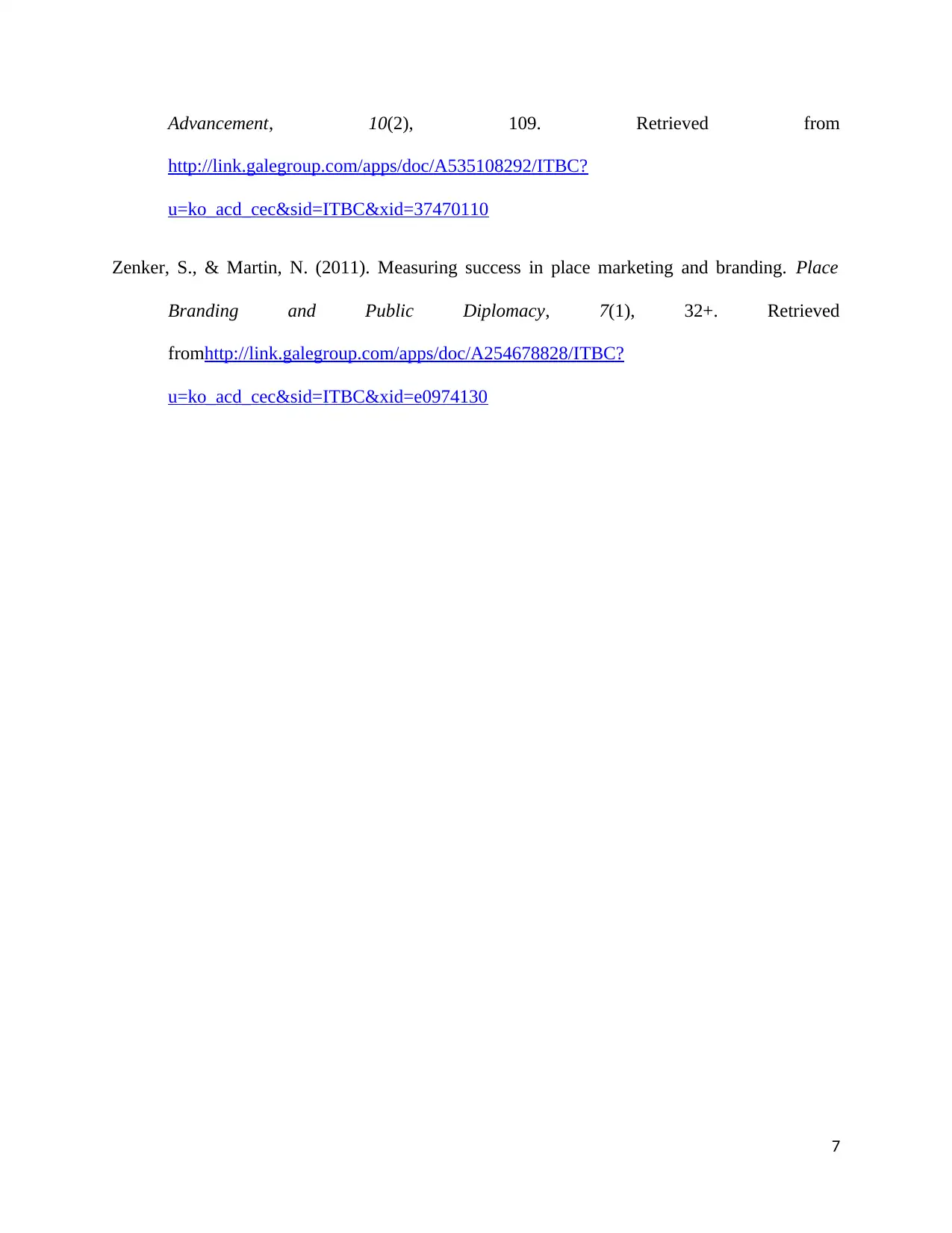
Advancement, 10(2), 109. Retrieved from
http://link.galegroup.com/apps/doc/A535108292/ITBC?
u=ko_acd_cec&sid=ITBC&xid=37470110
Zenker, S., & Martin, N. (2011). Measuring success in place marketing and branding. Place
Branding and Public Diplomacy, 7(1), 32+. Retrieved
fromhttp://link.galegroup.com/apps/doc/A254678828/ITBC?
u=ko_acd_cec&sid=ITBC&xid=e0974130
7
http://link.galegroup.com/apps/doc/A535108292/ITBC?
u=ko_acd_cec&sid=ITBC&xid=37470110
Zenker, S., & Martin, N. (2011). Measuring success in place marketing and branding. Place
Branding and Public Diplomacy, 7(1), 32+. Retrieved
fromhttp://link.galegroup.com/apps/doc/A254678828/ITBC?
u=ko_acd_cec&sid=ITBC&xid=e0974130
7
1 out of 11
Related Documents
Your All-in-One AI-Powered Toolkit for Academic Success.
+13062052269
info@desklib.com
Available 24*7 on WhatsApp / Email
![[object Object]](/_next/static/media/star-bottom.7253800d.svg)
Unlock your academic potential
Copyright © 2020–2025 A2Z Services. All Rights Reserved. Developed and managed by ZUCOL.



